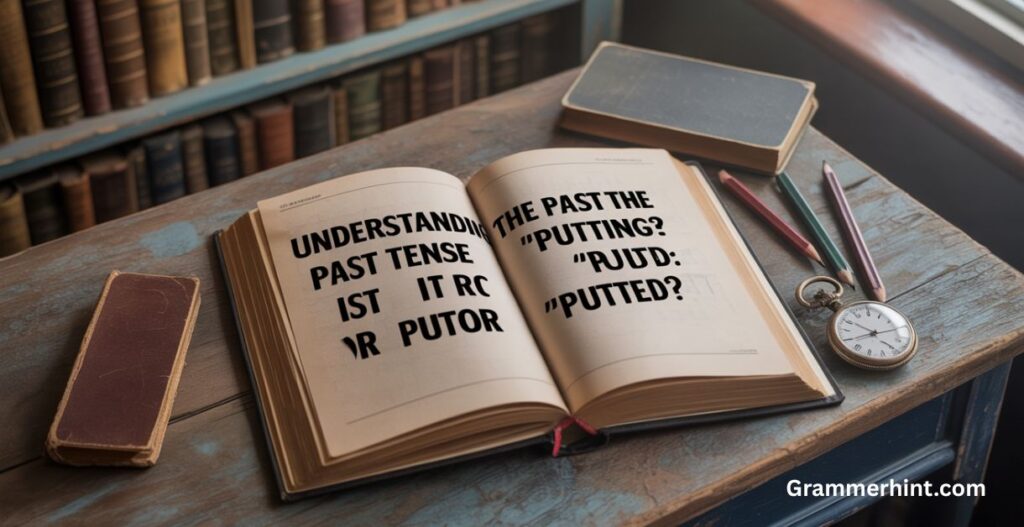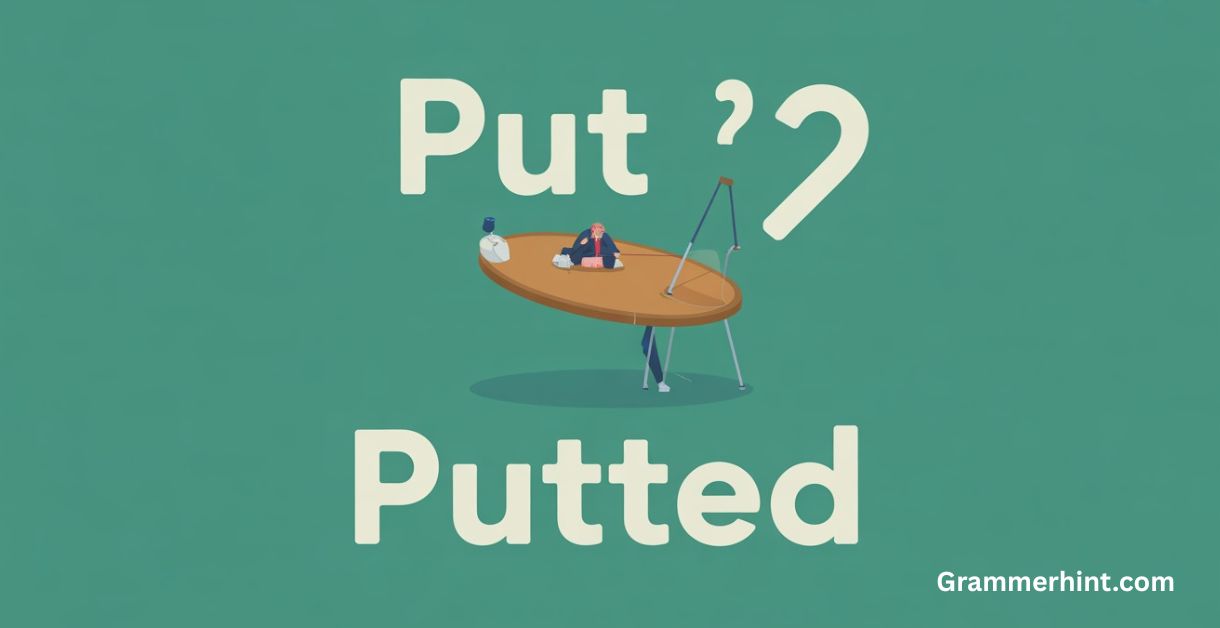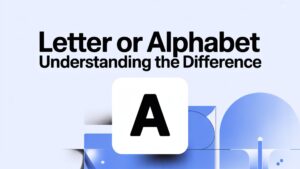In English grammar, verb usage often trips people up especially when a word looks like it should follow one rule but doesn’t. One such example?
The verb “put.” At first glance, it seems like it should work like “walk” or “jump.” You do it, you did it, and then you’re done. But then the question comes up: What’s the past tense of “putting”? Is it really “put,” or should it be “putted”?
Let’s break it down clearly, using real-life examples, scenario-based contexts, and bite-sized grammar explanations that make this one of the easiest grammar wins you’ll lock in all day.
What’s the Past Tense of “Put”?
Let’s start with the short answer:
The past tense of “put” is… “put.”
That’s it. No changes. No added -ed.
So if you’re asking, “Is ‘putted’ a word?” the answer is yes—but only in very specific contexts (more on that below). For most uses, especially when you’re describing placing something somewhere, you use “put” for both present and past tense.
Present Tense: I put my phone on the table every night.
Past Tense: Yesterday, I put my phone on the table.
Past Participle: I have put my phone on the table already.
Why Not “Putted”? Isn’t That the Regular Rule?
Here’s where irregular verbs throw people off. In standard verb conjugation rules, you add -ed to form the past tense:
- Walk → Walked
- Paint → Painted
- Smile → Smiled
But “put” doesn’t play by those rules. It’s part of a category called irregular past tense verbs, which includes words like:
- Run → Ran
- Go → Went
- Cut → Cut
- Hit → Hit
So, in this case, “put” remains “put” in the past tense, past participle, and sometimes even the present perfect tense.
Quick Table: “Put” Conjugation
| Tense | Verb Form |
|---|---|
| Present Tense | put |
| Past Tense | put |
| Past Participle | put |
| Present Participle | putting |
Is “Putted” Ever Correct?
Yes, but it depends on what you’re talking about. If you’re on a golf course, “putted” is 100% correct.
In golf:
- Present Tense: He putts the ball.
- Past Tense: He putted the ball into the hole.
So, when used as a sports-specific verb, especially in golf, putted is the correct past form of putt, which is not the same as “put.”
Example:
David putted the ball cleanly on the 18th green. It curved right into the hole.
This is where the confusion often happens: put ≠ putt.
They’re two entirely different verbs.
Scenario Example 1: Email Misuse of “Putted”
Imagine you’re sending an email to your manager:
Subject: Update on File Submissions
Hi Angela,
I just wanted to let you know I putted all the client documents into the shared folder.
Best,
Rachel
At first glance, it seems fine—until Angela reads it and cringes. “Putted” sounds off. That’s because “putted” is wrong in this context. You’re not playing golf with PDFs.
The corrected sentence should be:
I just wanted to let you know I put all the client documents into the shared folder.
Scenario Example 2: Golf-Specific Usage
On the flip side, here’s a golf-related email:
Subject: Tournament Recap
Hi Greg,
Great job out there today! I thought you putted really well, especially on the back nine. That 12-footer on 17 was smooth.
Cheers,
Tom
Here, “putted” is correct, because it refers to the golf action “putt.”
Common Mistakes with the Past Tense of “Put”
Let’s go over some common verb mistakes you’ll want to avoid.
❌ Incorrect:
- I putted the books on the shelf.
- He putted his phone on the desk.
✅ Correct:
- I put the books on the shelf.
- He put his phone on the desk.
Why is this important? Because clear communication depends on using the right verb forms.
Breaking It Down: “Put” vs. “Putted”

Let’s make it crystal clear.
| Situation | Correct Verb Form | Explanation |
|---|---|---|
| Placing an object | Put | Irregular verb, same in all tenses |
| Playing golf (past) | Putted | Past of the verb “putt” in golf |
| Present continuous | Putting | Ongoing action |
Real-Life Conversation Example
Let’s look at a real-life scenario:
Maya: Did you bring the files?
Jake: Yep, I put them on your desk this morning.
Maya: Perfect. I saw them, just wanted to confirm.
Now imagine this with the wrong verb:
Jake: Yep, I putted them on your desk this morning.
❌ Sounds like Jake thinks he’s on a putting green, not in an office.
“Put” Past Tense Examples
Here are a few more put past tense examples to solidify it in your memory:
- She put her keys on the counter.
- They put up the tent before the storm hit.
- I put the pizza in the oven 10 minutes ago.
Notice how the verb never changes—even though the time does.
Quick Grammar Tips for Beginners
- Not every verb ends in -ed in the past tense.
- Put is an irregular verb that doesn’t change.
- Context matters: “Putted” is valid—but only in golf.
- Double-check your writing. Simple past vs present continuous can trip people up.
Verb Conjugation Rules: Simple Yet Tricky
In general, here’s a quick way to remember how verbs work:
- Regular verbs: Add -ed (talk → talked)
- Irregular verbs: No standard rule (go → went, run → ran, put → put)
So in the case of “put”, the irregular pattern means it keeps the same form. No -ed, no doubling of consonants.
Final Thoughts: Avoiding “Putted” Mistakes
So let’s bring it home:
If you’re talking about placing something, use “put” in the present tense, past tense, and past participle.
Never use “putted” unless you’re on a golf course.









